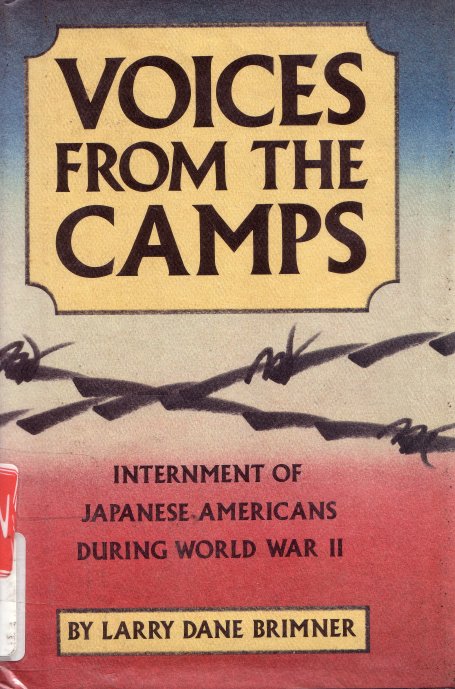Voices from the Camps: Internment of Japanese Americans during World War II (book)
Creators: Larry Dane Brimner
Brief overview book for juvenile audiences on the wartime removal and incarceration of Japanese Americans by prolific children's book author Larry Dane Brimner. The "voices" of the title are taken from testimony by Japanese Americans before the Commission on Wartime Relocation and Internment of Civilians (CWRIC).
Synopsis
Voices from the Camps tells its story in eight chapters and an afterword. After an introductory chapter, the next two cover Japanese immigration and the anti-Japanese movement and events leading to Executive Order 9066 . The next two chapters cover the roundup of Japanese Americans and their journey to concentration camps and life in those camps. A chapter on Japanese American military service follows, with the last two chapters covering the closing of the camps and return to the West Coast and the redress movement . The afterword draws parallels with contemporary issues and cites the need to keep vigilant about civil rights.
Numerous quotations from Nikkei testimony before the CWRIC are included throughout the book. The book is illustrated with two sixteen-page photographic inserts. End materials include a glossary and brief bibliography.
Additional Information
Author Larry Dane Brimner (1949– ) was born in Florida but raised in Kodiak Island, Alaska, where he went to high school. After graduating from San Diego State University, he become a high school writing teacher in El Centro, California, and later taught at San Diego State after obtaining a master's degree there in 1984. After publishing his first book for children in 1987, he quit to become a full-time writer. According to his website, he has authored more that 175 books—both fiction and non-fiction—for children of various ages.
Though generally well researched—in the acknowledgements, Brimner mentions major Japanese American institutions such as the Japanese American National Museum , National Japanese American Historical Society , and Japanese American National Library as well as such well-known community leaders as Sue Kunitomi Embrey and Violet deChristoforo —it does contain a number of minor errors. Among them: it confuses segregationist Congressman John Rankin with pacifist Congresswoman Jeannette Rankin (page 13); defines Military Area #2 as "[e]verything else [besides Military Area #1] west of the Mississippi" (33; Military Area #2 included only the portions of Washington, Oregon, California, and Oregon not part of Military Area #1); claims that the Supreme Court ruled on the Yasui and Hirabayashi cases in December 1944 (40); claims the "Fair Play Committee" encouraged "no" answers to the loyalty questions (60; the Heart Mountain Fair Play Committee formed a year after the loyalty questionnaire episode, and its members generally answered "yes" to the loyalty questions); misidentifies the war hero Kazuo Masuda as "Masao" Masuda (67).
Find in the Digital Library of Japanese American Incarceration
Voices from the Camps: Internment of Japanese Americans during World War II
This item has been made freely available in the Digital Library of Japanese American Incarceration , a collaborative project with Internet Archive .
Might also like
A Fence Away from Freedom: Japanese Americans and World War II
by Ellen Levine;
Dear Miss Breed: True Stories of the Japanese American Incarceration During World War II and a Librarian Who Made a Difference
by Joanne Oppenheim;
The Invisible Thread
by Yoshiko Uchida
| Author | Larry Dane Brimner |
|---|---|
| Pages | 110 |
| Publication Date | 1994 |
For More Information
Author website: http://www.brimner.com/ .
